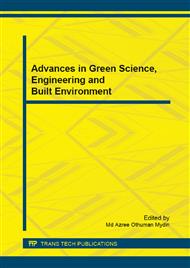p.265
p.269
p.273
p.277
p.282
p.286
p.290
p.294
p.298
Towards a Green Quail Meat Production through Life Cycle Perspective
Abstract:
Commercial conventional of poultry production at largest scale in this country show escalation year by year, together with high demand of poultry product in Malaysia market. The aim of this research was to identify environmental impact hotspots in the whole supply chain of quail meat production in Jasin, Melaka. At present, assessment of environmental impact of poultry production in Malaysia is lacking.Therefore, this study was conducted to evaluate the energy use and environmental impacts of quail meat production in Jasin,Melaka through life cycle assessment.A cradle-to-gate assessment including distribution stage was conducted based on the ISO 14040/14044 guidelines.Life cycle inventory data was collected from farmers and available literature. Life cycle impact assessment was conducted toidentify environmental impacts using the available method in theopenLCA software.Life cycle processes related to feed production, electricity and water were identified as the major hotspots for energy and they also showed the most significant contribution in GWP and acidication potential among the environmental impacts categories. Improving efficiency of energy and water consumption will reduce the environmental burden associated with quail meat production.Thus, at the end of this research, it will able to make industry player to understand and take into consideration the solutions in order to promote a green quail meat production.
Info:
Periodical:
Pages:
282-285
Citation:
Online since:
March 2015
Price:
Сopyright:
© 2015 Trans Tech Publications Ltd. All Rights Reserved
Share:
Citation:


